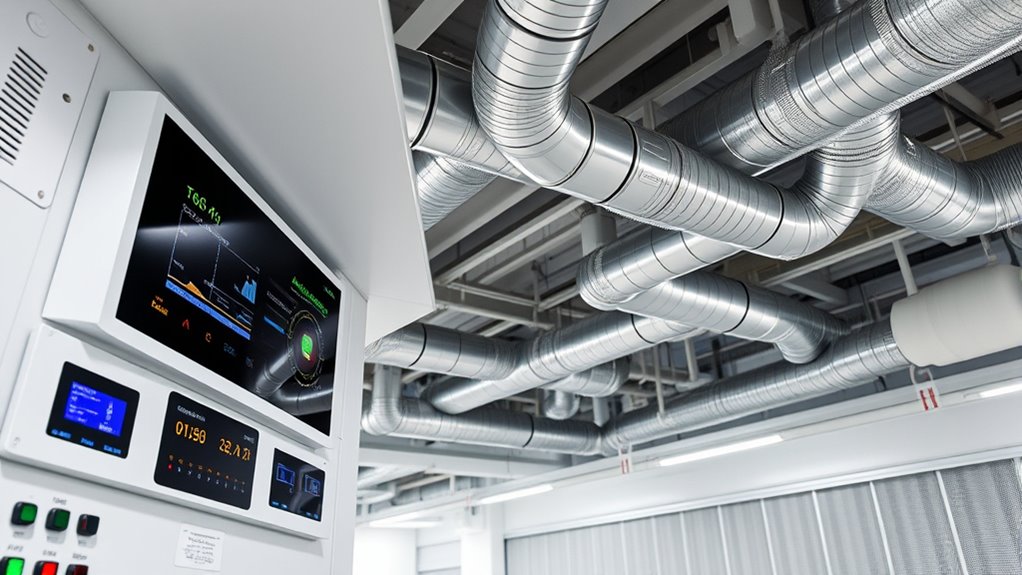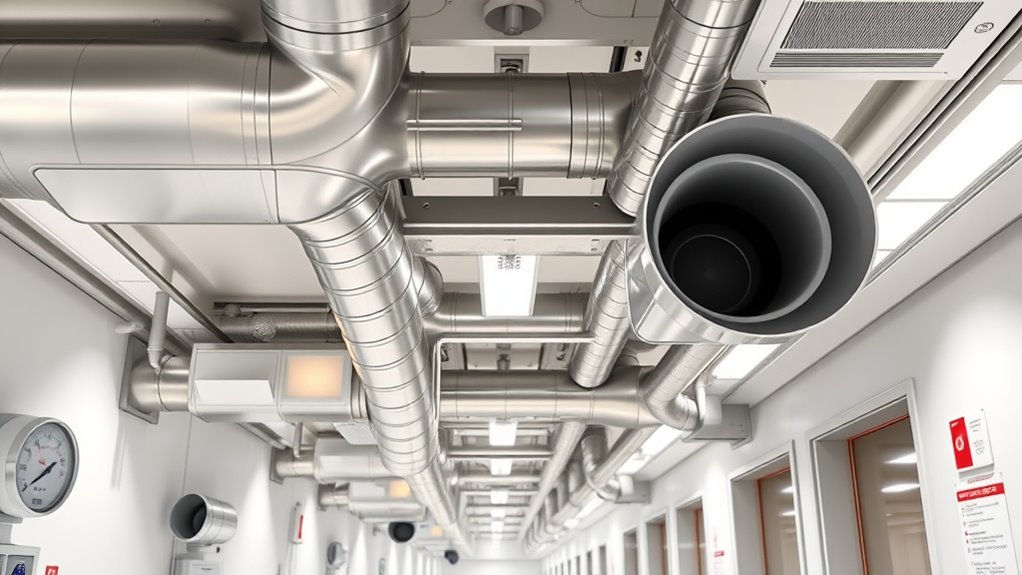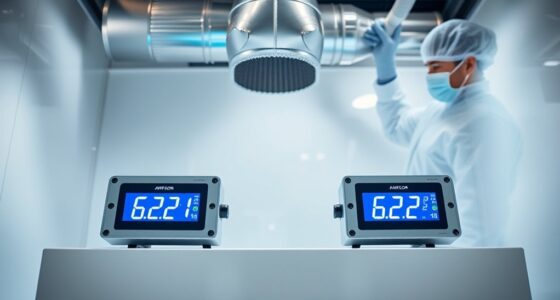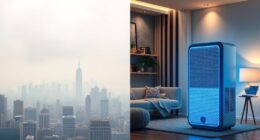Understanding ASHRAE 170 is key to designing effective healthcare ventilation systems that protect patients and staff. It sets standards for air exchange rates, filtration, and system performance, ensuring contaminated air is quickly removed and fresh air circulates properly. By following these guidelines, you help prevent infections and maintain safe indoor environments. If you want to make certain your system is up to standard, there’s much more to explore about how to implement these practices effectively.
Key Takeaways
- ASHRAE 170 sets minimum air change rates for healthcare areas, like 2-6 ACH for patient rooms and 15+ ACH for operating rooms.
- It emphasizes high-efficiency filtration, such as HEPA filters, to remove airborne pathogens effectively.
- The standard guides proper design, installation, and regular maintenance of ventilation systems in healthcare settings.
- Compliance ensures safe indoor air quality, infection control, and reduces the risk of airborne disease transmission.
- Adhering to ASHRAE 170 promotes healthier environments for patients and staff through effective airflow management.

Have you ever wondered how healthcare facilities guarantee safe and effective indoor air quality? It all comes down to strict ventilation standards designed to minimize infection risks and promote a healthy environment. Central to these standards is ASHRAE 170, a guideline specifically tailored for healthcare settings. Understanding how it works can help you appreciate the importance of proper ventilation strategies, especially when it comes to maintaining ideal air exchange and filtration standards.
Healthcare facilities rely on ASHRAE 170 standards to ensure safe, effective indoor air quality.
In healthcare environments, air exchange is critical because it ensures a constant flow of fresh air while removing contaminated air. ASHRAE 170 specifies minimum air change rates based on different clinical areas, such as patient rooms, operating theaters, and isolation rooms. For instance, a typical patient room might require 2 to 6 air changes per hour, whereas operating rooms often need upwards of 15 air changes. This variation ensures that airborne contaminants are quickly diluted and removed, reducing the risk of infection transmission. You need to understand that inadequate air exchange can lead to stagnant air pockets, which compromise patient safety and staff health. Proper ventilation design also involves selecting appropriate filtration standards to effectively trap airborne pathogens.
Filtration standards are equally essential in maintaining indoor air quality in healthcare facilities. ASHRAE 170 emphasizes the use of high-efficiency filters, such as HEPA filters, especially in critical zones like operating rooms, isolation wards, and laboratories. These filters are designed to trap airborne particles, including bacteria, viruses, and particulate matter, effectively preventing their recirculation into the indoor environment. When your facility adheres to these filtration standards, you’re actively reducing the risk of healthcare-associated infections. Proper filtration also helps protect HVAC equipment from contamination and prolongs system lifespan, ensuring that ventilation remains effective over time.
Implementing ASHRAE 170 isn’t just about meeting code requirements; it’s about creating a healthcare environment where safety is prioritized. You need to work with HVAC professionals who understand these standards thoroughly, ensuring proper system design, installation, and maintenance. Regular testing and inspection of air exchange rates and filters are essential to maintain compliance and ideal performance. These proactive measures guarantee that ventilation systems continue to operate as intended, providing a safe space for patients and staff alike.
In essence, understanding ASHRAE 170 for healthcare ventilation means recognizing the importance of proper air exchange and filtration standards. By ensuring these elements are carefully designed and maintained, you’re creating a safer, healthier environment that supports healing and reduces infection risks. It’s not just about following rules—it’s about actively protecting everyone in your healthcare facility through meticulous ventilation practices.
Frequently Asked Questions
How Often Should Healthcare Facilities Review ASHRAE 170 Updates?
You should review ASHRAE 170 updates at least annually to guarantee your healthcare facility stays compliant. Regular ventilation maintenance and staff training are essential to incorporate new standards effectively. By staying current, you can identify any gaps in your ventilation system and adapt protocols promptly. Continuous review helps maintain a safe environment for patients and staff, ensuring your facility adheres to the latest healthcare ventilation guidelines and best practices.
What Are the Common Challenges in Implementing ASHRAE 170 Standards?
You may face compliance challenges when implementing ASHRAE 170 standards, especially if staff training isn’t thorough or ongoing. Making sure that your team understands ventilation requirements and maintaining consistent adherence can be difficult. Additionally, integrating new standards into existing systems often requires resources and coordination, which can hinder smooth implementation. Staying updated and investing in thorough training helps overcome these challenges and guarantees your facility meets all ventilation safety requirements.
How Does ASHRAE 170 Impact Healthcare Facility Operational Costs?
ASHRAE 170 can increase your healthcare facility’s operational costs by requiring enhanced ventilation systems that boost energy use. However, focusing on energy efficiency helps you reduce expenses, and strategic maintenance planning ensures systems run effectively, cutting long-term costs. While initial investments might be higher, adhering to ASHRAE 170 ultimately promotes a safer environment without considerably draining your budget, especially when you optimize energy and maintenance strategies.
Are There Specific Training Requirements for Staff on ASHRAE 170?
You need to immerse yourself in staff training on ASHRAE 170 because it’s the secret sauce to compliance requirements. Without proper training, your team might as well be flying blind in a storm. The training covers everything from ventilation standards to infection control. It’s not just a box to check; it’s your frontline defense. Stay ahead, stay compliant, and empower your staff to master these critical healthcare ventilation rules.
How Does ASHRAE 170 Integrate With Other Healthcare Facility Codes?
You need to guarantee that ASHRAE 170 integrates seamlessly with other healthcare facility codes by verifying code compliance across all standards. It works alongside local building codes, OSHA, and CMS requirements, emphasizing ventilation standards that protect patient safety. By staying updated on how ASHRAE 170 aligns with these regulations, you can design and operate healthcare environments that meet legal and safety benchmarks efficiently.
Conclusion
By understanding ASHRAE 170, you guarantee healthcare spaces are safe and comfortable for everyone. Implementing its standards isn’t just about compliance; it’s about prioritizing patient and staff well-being. Are you ready to take the necessary steps to create healthier environments? Remember, proper ventilation can be the difference between healing and harm. Embrace ASHRAE 170, and make healthcare facilities safer, healthier, and more effective for all who enter.










